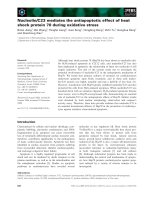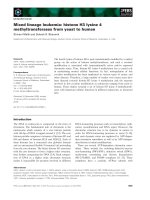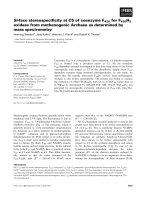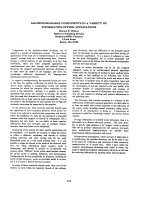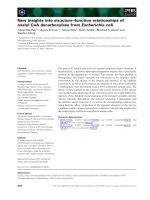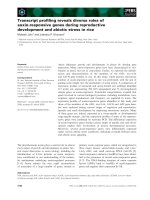Báo cáo khoa học: "Error Profiling: Toward a Model of English Acquisition for Deaf Learners" ppt
Bạn đang xem bản rút gọn của tài liệu. Xem và tải ngay bản đầy đủ của tài liệu tại đây (105.38 KB, 8 trang )
Error Profiling: Toward a Model of English Acquisition for Deaf
Learners
Lisa N. Michaud and Kathleen F. McCoy
Dept. of Computer and Info. Sciences, University of Delaware, Newark, DE 19716, USA
michaud,mccoy @cis.udel.edu
/>Abstract
In this paper we discuss our approach
toward establishing a model of the ac-
quisition of English grammatical struc-
tures by users of our English language
tutoring system, which has been de-
signed for deaf users of American Sign
Language. We explore the correlation
between a corpus of error-tagged texts
and their holistic proficiency scores as-
signed by experts in order to draw ini-
tial conclusions about what language
errors typically occur at different levels
of proficiency in this population. Since
errors made at lower levels (and not
at higher levels) presumably represent
constructions acquired before those on
which errors are found only at higher
levels, this should provide insight into
the order of acquisition of English
grammatical forms.
1 Introduction
There have been many theories of language acqui-
sition proposing a stereotypical order of acquisi-
tion of language elements followed by most learn-
ers, and there has been empirical evidence of such
an order among morphological elements of lan-
guage (cf. (Bailey et al., 1974; Dulay and Burt,
1975; Larsen-Freeman, 1976)) and some syntac-
tic structures (cf. (Brown and Hanlon, 1970;
Gass, 1979)). There is indication that these re-
sults may be applied to any L1 group acquiring
English (Dulay and Burt, 1974; Dulay and Burt,
1975), and some research has focused on develop-
ing a general account of acquisition across a broad
range of morphosyntactic structures (cf. (Piene-
mann and H˚akansson, 1999)). In this work, we
explore how our second language instruction sys-
tem, ICICLE, has generated the need for model-
ing such an account, and we discuss the results
of a corpus analysis we have undertaken to fulfill
that need.
1.1 ICICLE: an Overview
ICICLE (Interactive Computer Identification and
Correction of Language Errors) is an intelli-
gent tutoring system currently under development
(Michaud and McCoy, 1999; Michaud et al.,
2000; Michaud et al., 2001). Its primary function
is to tutor deaf students on their written English.
Essential to performing that function is the ability
to correctly analyze user-generated language er-
rors and produce tutorial feedback to student per-
formance which is both correct and tailored to the
student’s language competence. Our target learn-
ers are native or near-native users of American
Sign Language (ASL), a distinct language from
English (cf. (Baker and Cokely, 1980)), so we
view the acquisition of skills in written English as
the acquisition of a second language for this pop-
ulation (Michaud et al., 2000).
Our system uses a cycle of user input and sys-
tem response, beginning when a user submits a
piece of writing to be reviewed by the system.
The system determines the grammatical errors in
the writing, and responds with tutorial feedback
aimed at enabling the student to perform correc-
tions. When the student has revised the piece, it
is re-submitted for analysis and the cycle begins
again. As ICICLE is intended to be used by an
individual over time and across many pieces of
writing, the cycle will be repeated with the same
individual many times.
user
interface
Error Identifcation
Module
Grammar Model
Domain Knowl.
Response Generation
Module
System History
Dialogue History
Database of
Grammatical
Concepts
Augmented
Parsing
Grammar
text
highlighted errors
tutoring session
errors
User Model Domain KB
Figure 1: ICICLE system architecture.
Figure 1 contains a diagram of ICICLE’s over-
all architecture and the cycle we have described.
It executes between the User Interface, the Error
Identification Module (which performs the syn-
tactic analysis of user writing), and the Response
Generation Module (which builds the feedback to
the user based on the errors the user has commit-
ted). The work described in this paper focuses on
the development of one of the sources of knowl-
edge used by both of these processes, a compo-
nent of the User Model representing the user’s
grammatical competence in written English.
1.2 A Need for Modeling L2A Status
What currently exists of the ICICLE system is
a prototype application implemented in a graph-
ical interface connected to a text parser that uses
a wide-coverage English grammar augmented by
“mal-rules” capturing typical errors made by our
learner population. It can recognize and label
many grammatical errors, delivering “canned”
one- or two-sentence explanations of each error
on request. The user can then make changes
and resubmit the piece for additional analysis.
We have discussed in (Schneider and McCoy,
1998) the performance of our parser and mal-rule-
augmented grammar and the unique challenges
“She is teach piano on Tuesdays.”
Beginner: Inappropriate use of auxiliary
and verb morphology problems.
“She teaches piano on Tuesdays.”
Intermediate: Missing appropriate +ing
morphology.
“She is teaching piano on Tuesdays.”
Advanced: Botched attempt at passive
formation.
“She is taught piano on Tuesdays.”
Figure 2: Possible interpretations of non-
grammatical user text.
faced when attempting to cover non-grammatical
input from this population.
In its current form, when the parser obtains
more than one possible parse of a user’s sentence,
the interface chooses arbitrarily which one it will
assume to be representative of which structures
the user was attempting. This is undesirable, as
one challenge that we face with this particular
population is that there is quite a lot of variabil-
ity in the level of written English acquisition. A
large percentage of the deaf population has read-
ing/writing proficiency levels significantly below
their hearing peers, and yet the population repre-
sents a broad range of ability. Among deaf 18-
year-olds, about half read at or below a fourth
grade level, while about 10% read above the
eighth-grade level (Strong, 1988). Thus, even
when focused on a subset of the deaf population
(e.g., deaf high school or college students), there
is significant variability in the writing proficiency.
The impact of this variability is that a particular
string of words may have multiple interpretations
and the most likely one may depend upon the pro-
ficiency level of the student, as illustrated in Fig-
ure 2. We are therefore currently developing a
user model to address the system’s need to make
these parse selections intelligently and to adapt
tutoring choices to the individual (Michaud and
McCoy, 2000; Michaud et al., 2001).
The model we are developing is called
SLALOM. It is a representation of the user’s abil-
ity to correctly use each of the grammatical “fea-
tures” of English, which we define as incorpo-
rating both morphological rules such as plural-
izing a noun with +S and syntactic rules such
as the construction of prepositional phrases and
S V O sentence patterns. Intuitively, each unit
in SLALOM corresponds to a set of grammar
rules and mal-rules which realize the feature. The
information stored in each of these units repre-
sents observations based on the student’s perfor-
mance over the submission of multiple pieces of
writing. These observations will be abstracted
into three tags, representing performance that is
consistently good (acquired), consistently flawed
(unacquired), or variable (ZPD
1
) to record the
user’s ability to correctly execute each structure
in his or her written text.
1.3 An Incomplete Model
A significant problem that we must face in gen-
erating the tags for SLALOM elements is that
we would like to infer tags on performance ele-
ments not yet seen in a writer’s production, bas-
ing those tags on what performance we have been
able to observe so far. We have proposed (Mc-
Coy et al., 1996; Michaud and McCoy, 2000) that
SLALOM be structured in such a way as to cap-
ture these expectations by explicitly representing
the relationships between grammatical structures
in terms of when they are acquired; namely, indi-
cating which features are typically acquired be-
fore other features, and which are typically ac-
quired at the same time. With this information
available in the model, SLALOM will be able
to suggest that a feature typically acquired be-
fore one marked “acquired” is most likely also
acquired, or that a feature co-acquired with one
marked “ZPD” may also be something currently
being mastered by the student. The corpus anal-
ysis we have undertaken is meant to provide this
structure by indicating a partial ordering on the
acquisition of grammatical features by this popu-
lation of learners.
1.4 Applications
Having the SLALOM model marked with gram-
matical features as being acquired, unacquired, or
ZPD will be very useful in at least two different
1
Zone of Proximal Development: see (Michaud and Mc-
Coy, 2000) for discussion. These are presumably the fea-
tures the learner is currently in the process of acquiring and
thus we expect to see variation in the user’s abilityto execute
them.
ways. The first is when deciding which possi-
ble parse of the input best describes a particular
sentence produced by a learner. When there are
multiple parses of an input text, some may place
the “blame” for detected errors on different con-
stituents. In order for ICICLE to deliver relevant
instruction, it needs to determine which of these
possibilities most likely reflects the actual perfor-
mance of the student. We intend for the parse se-
lection process to proceed on the premise that fu-
ture user performance can be predicted based on
the patterns of the past. The system can generally
prefer parses which use rules representing well-
formed constituents associated with “acquired”
features, mal-rules from the “unacquired” area,
and either correct rules or mal-rules for those fea-
tures marked “ZPD.”
A second place SLALOM will be consulted is
in deciding which errors will then become the
subjects of tutorial explanations. This decision
is important if the instruction is to be effective.
It is our wish for ICICLE to ignore “mistakes”
which are slip-ups and not indicative of a gap in
language knowledge (Corder, 1967) and to avoid
instruction on material beyond the user’s current
grasp. It therefore will focus on features marked
“ZPD”—those in that “narrow shifting zone di-
viding the already-learned skills from the not-yet-
learned ones” (Linton et al., 1996), or the frontier
of the learning process. ICICLE will select those
errors which involve features from this learner’s
learning frontier and use them as the topics of its
tutorial feedback.
With the partial order of acquisition repre-
sented in the SLALOM model as we have de-
scribed, these two processes can proceed on the
combination of the data contained in the previous
utterances supplied by a given learner and the “in-
tuitions” granted by information on typical learn-
ers, supplementing empirical data on the specific
user’s mastery of grammatical forms with infer-
ences on what that means with respect to other
forms related to those through the order of acqui-
sition.
2 Profiling Language Errors
We have established the need for a description of
the general progress of English acquisition as de-
termined by the mastery of grammatical forms.
We have undertaken a series of studies to estab-
lish an order-of-acquisition model for our learner
population, native users of American Sign Lan-
guage.
In our first efforts, we have been guided by the
observation that the errors committed by learn-
ers at different stages of acquisition are clues to
the natural order that acquisition follows (Corder,
1967). The theory is that one expects to find er-
rors on elements currently being acquired; thus
errors made by early learners and not by more
advanced learners represent structures which the
early learners are working on but which the ad-
vanced learners have acquired. Having obtained
a corpus of writing samples from 106 deaf indi-
viduals, we sought to establish “error profiles”—
namely, descriptions of the different errors com-
mitted by learners at different levels of language
competence. These profiles could then be a piece
of evidence used to provide an ordering struc-
ture on the grammatical elements captured in the
SLALOM model.
This is an overview of the process by which we
developed our error profiles:
Goal : to have error profiles that indicate what
level of acquisition is most strongly associ-
ated with which grammatical errors. It is
important that the errors correspond to our
grammar mal-rules so that the system can
prefer parses which contain the errors most
consistent with the student’s level of acqui-
sition.
Method :
1. Collect writing samples from our user
population
2. Tag samples in a consistent manner
with a set of error codes (where these
codes have an established correspon-
dence with the system grammar)
3. Divide samples into the levels of acqui-
sition they represent
4. Statistically analyze errors within each
level and compare to the magnitude of
occurrence at other levels
5. Analyze resulting findings to determine
a progression of competence
In (Michaud et al., 2001) we discuss the initial
steps we took in this process, including the de-
velopment of a list of error codes documented by
a coding manual, the verification of our manual
and coding scheme by testing inter-coder reliabil-
ity in a subset of the corpus (where we achieved
a Kappa agreement score (Carletta, 1996) of
)
2
, and the subsequent tagging of the en-
tire corpus. Once the corpus was annotated with
the errors each sentence contained, we obtained
expert evaluations of overall proficiency levels
performed by ESL instructors using the national
Test of Written English (TWE) ratings
3
. The ini-
tial analysis we go on to describe in (Michaud
et al., 2001) confirmed that clustering algorithms
looking at the relative magnitude of different er-
rors grouped the samples in a manner which cor-
responded to where they appeared in the spectrum
of proficiency represented by the corpus. The
next step, the results of which we discuss here,
was to look at each error we tagged and the ability
of the level of the writer’s proficiency to predict
which errors he or she would commit. If we found
significant differences in the errors committed by
writers of different TWE scores, then we could
use the errors to help organize the SLALOM ele-
ments, and through that obtain data on which er-
rors to expect given a user’s level of proficiency.
2.1 Toward an error profile
Although our samples were scored on the six-
point TWE scale, we had sparse data at either end
of the scale (only 5% of the samples occurring in
levels 1, 5, and 6), so we concentrated our efforts
on the three middle levels (2, 3, and 4), which we
renamed low, middle, and high.
Our chosen method of data exploration was
Multivariate Analysis of Variance (MANOVA).
An initial concern was to put the samples on equal
footing despite the fact that they covered a broad
range in length—from 2 to 58 sentences—and
there was a danger that longer samples would tend
2
We also discuss why we were satisfied with this score
despite only being in the range of what Carletta calls “tenta-
tive conclusions.”
3
Although these samples were relatively homogeneous
with respect to the amount of English training and the age
of the writer, we expected to see a range of demonstrated
proficiency for reasons discussed above. We discuss later
why the ratings were not as well spread-out as we expected.
no parse
plural +S
extra conjunction
adj placement
verb formation
extra preposition
infinitive use
wrong tense in context
"activity" phrase
adj formation
adverb placement
incorrect preposition
missing "to be" verb
missing object of verb
missing preposition
missing auxiliary
missing determiner
missing subject
extra auxiliary
adj/adv confusion
comparison phrase
extra relative pronoun
extra determiner
here/there as pronoun
voice confusion
no errors found
should be pronominalized
Significant Results
Low Mid High
incorrect relative pronoun
KEY:
Levels of intensity indicate differences which were observed
but which are not statistically different
(darker = average occurrence of error is higher)
Insignificant Results
Figure 3: Illustrating the errors each level is most
likely to commit.
to have higher error counts in every category sim-
ply because the authors had more opportunity to
make errors. We therefore used two dependent
variables in our analysis: the TWE score and the
length of the sample, testing the ability of the two
combined to predict the number of times a given
error occurred. We ran the MANOVA using both
sentence count and word count as possible length
variables, and in both runs we obtained many sta-
tistically significant differences between the mag-
nitude at which writers at different TWE levels
committed certain errors. These differences are
illustrated in Figure 3, which shows the results on
a subset of the 47 error code tags for which we
got discernible results
4
.
In the figure, a bar indicates that this level of
proficiency committed this type of error more fre-
quently than the others. If two of the three levels
are both marked, it means that they both commit-
ted the error more frequently than the third, but
the difference between those two levels was unre-
markable. Solid shading indicates results which
were statistically significant (with an omnibus test
yielding of significance level of
), and inten-
sity differences (e.g., black for extra preposition
in the low level, but grey in the middle level) in-
dicate a difference that was not significant. In the
example we just mentioned, the low-level writ-
ers committed more extra preposition errors than
the high-level writers with a significance level of
0.0082, and the mid-level writers also commit-
ted more of these errors than the high-level writ-
ers with a significance of .0083. The compari-
son of the low and middle levels to each other, on
the other hand, showed that the low-level learners
committed more of this error, but that the result
was strongly insignificant at .5831.
The cross-hatched and diagonal-striped results
in the figure indicate results which did not satisfy
the cutoff of
for significance, but were con-
sidered both interesting and close enough to sig-
nificance to be worth noting. The diagonal stripes
have “less intensity” and thus indicate the same
relationship to the cross-hatched bars as the gray
does to the black—a difference in the data which
indicates a lower occurrence of the error which
is not significantly distinguished (e.g., high-level
learners committed extra relative pronoun errors
less often than mid-level learners, and both high-
and mid-level learners committed it more often
than the low-level learners), but, again, not to a
significant extent.
Notice that the overall shape of the figure sup-
ports the notion of an order of acquisition of fea-
tures because one can see a “progression” of er-
rors from level to level. Very strongly support-
ive of this intuition are the first and last errors in
the figure: “no parse,” indicating that the coder
4
“Activity” refers to the ability to correctly form a
gerund-fronted phrase describing an activity, such as “I re-
ally like walking the dog;” “comparison phrase” refers to
the formation of phrases such as “He is smarter than she;”
“voice” refers to the confusion between using active and pas-
sive voice, such as “The soloist was sung.”
was unable to understand the intent of the sen-
tence, statistically more often at the lowest level
than the at the other two levels, while “no er-
rors found” was significantly most prevalent at
the highest level (both with a significance level
of
).
Other data which is more relevant to our goals
also presents itself. The lowest level exhibited
higher numbers of errors on such elementary lan-
guage skills as putting plural markers on nouns,
placing adjectives before the noun they modify,
and using conjunctions to concatenate clauses
correctly. Both the low and middle levels strug-
gled with many issues regarding forming tenses,
and also exhibited “ASLisms” in their English,
such as the dropping of constituents which are ei-
ther not explicitly realized in ASL (such as de-
terminers, prepositions, verb subjects and objects
which are established discourse entities in focus,
and the verb “TO BE”), or the treatment of certain
discourse entities as they would be in ASL (e.g.,
using “here” as if it were a pronoun). While be-
ginning learners struggled with more fundamental
problems with subordinate clauses such as miss-
ing gaps, the more advanced learners struggled
with using the correct relative pronouns to con-
nect those clauses to their matrix sentence. Where
the lower two levels committed more errors with
missing determiners, the highest level among our
writers had learned the necessity of determin-
ers in English but was over-generalizing the rule
and using them where they were not appropriate.
Finally, the upper level learners were beginning
to experiment with more complex verb construc-
tions such as the passive voice. All of this begins
to draw a picture of the sequence in which these
structures are mastered across these levels.
2.2 Discussion
While Figure 3 is meant to illustrate how the three
different levels committed different sets of errors,
it is clear that this picture is incomplete. The low
and middle levels are insufficiently distinguished
from each other, and there were very few errors
committed most often by the highest level. Most
importantly, many of the distinctions between lev-
els were not achieved to a significant degree.
One of the reasons for these problems is the
fact that our samples are concentrated in only
three levels in the center of the TWE spectrum.
We hope to address this in the future by acquiring
additional samples. Another problem which addi-
tional samples will help to solve is sparseness of
data. Across our 106 samples and 68 error codes,
only 30 codes occur more than 25 times in the cor-
pus, and only 21 codes occur more than 50 times.
Most of our insignificant differences come from
error codes with very low frequency, sometimes
occurring as infrequently as 7 times.
What we have established is promising, how-
ever, in that it does show statistically significant
data spanning nearly every syntactic category.
Additional samples must be collected and ana-
lyzed to obtain more statistical significance; how-
ever, the methodology and approach are proven
solid by these results.
3 Future Work: Performance Profiles
If we were to stop here, then our user model de-
sign would simply be to group the SLALOM con-
tents addressed by these errors in an order accord-
ing to how they fell into the distribution shown
in Figure 3, assuming essentially that those errors
falling primarily in the low-level group represent
structures that are learned first, followed by those
in the low/middle overlap area, followed by those
which mostly the mid-level writers were strug-
gling, followed finally by those which mostly
posed problems for our highest-level writers.
Given this structure, and a general classifica-
tion of a given user, if we are attempting to select
between competing parses for a sentence written
by this user, we can prefer a sentence whose er-
rors most closely fit those for the profile to which
the user belongs. However, up until now we have
only gathered information on the errors commit-
ted by our learner population, and thus we still
have no information on a great deal of gram-
matical constructions. Consider that some types
of grammatical constructions may be avoided or
used correctly at low levels but that the system
would have no knowledge of this. By only mod-
eling the errors, we fail to capture the acquisition
order data provided by knowing what structures
a writer can successfully execute at the different
levels. Therefore, the sparse data problems we
faced in this work are only partly explained by
the small corpus and some infrequent error codes.
They are also explained by the fact that errors are
only one half of the total picture of user perfor-
mance.
Although we experimented in this work with
equalizing the error counts using different length
measures, we did not have access to the num-
bers that would have provided the most meaning-
ful normalization: namely, the number of times a
structure is attempted. It is our belief that infor-
mation on the successful structures in the users’
writing would give us a much clearer view of the
students’ performance at each level. Tagging all
sentences for the correct structures, however, is
an intractable task for a human coder. On the
other hand, while it is feasible to have this in-
formation collected computationally through our
parser, we are still faced with the problem of com-
peting parses for many sentences. Our methodol-
ogy to address this problem is to use the human-
generated error codes to select among the parses
trees in order to gather statistics on fully-parsed
sentences.
We have therefore created a modified version
of our user interface which, when given a sam-
ple of writing from our corpus, records all com-
peting parse trees for all sentences to a text file
5
.
Another application has been developed to com-
pare these system-derived parse trees against the
human-assigned error code tags for those same
sentences to determine which tree is the closest
match to human judgment. To do this, each tree
is traversed and all constituents corresponding
to mal-rules are recorded as the equivalent error
code tag. The competing lists of errors are then
compared against the sequence determined by the
human coder via a string alignment/comparison
algorithm which we discuss in (Michaud et al.,
2001).
With the “correct” parse trees indicated for
each sentence, we will know which grammar con-
stituents each writer correctly executed and which
others had to be parsed using our mal-rules. The
same statistical techniques described above can
then be applied to form performance profiles for
capturing statistically significant differences in
the grammar rules used by students within each
level. This will give us a much more detailed
5
Thanks are due to Greg Silber for his work on revising
our interface and creating this variation.
description of acquisition status on language ele-
ments throughout the spectrum represented by our
sample population.
The implication of having such information
is that once it is translated into the structure
of our SLALOM user model, performance on
a previously-unseen structure may be predicted
based on what performance profile the user most
closely fits and what tag that profile typically as-
signs to the structure in question; as mentioned
earlier in this text, features typically acquired be-
fore a structure on which the user has demon-
strated mastery can be assumed to be acquired
as well. Those structures which are well be-
yond the user’s area of variable performance (his
or her current area of learning) are most likely
unacquired. Since we view the information in
SLALOM as projecting probabilities onto the
rules of the grammar, intuitively this will allow
the user’s mastery of certain rules to project dif-
ferent default probabilities on rules which have
not yet been seen in the user’s language usage.
With this information, ICICLE will then be
able to make principled decisions in both pars-
ing and tutoring tasks based on a hybrid of direct
knowledge about the user’s exhibited proficiency
on grammatical structures and the indirect knowl-
edge we have derived from typical learning pat-
terns of the population.
4 Conclusion
In this paper we have addressed an empirical ef-
fort to establish a typical sequence of acquisition
for deaf learners of written English. Our initial
results show much promise and are consistent in
many ways with intuition. Future work will ap-
ply the same methodology but expand beyond the
analysis of user errors to the analysis of the com-
plete image of user performance, including those
structures which a user can successfully execute.
When completed, our model will enable a com-
plex tutoring tool to intelligently navigate through
multiple competing parses of user text and to fo-
cus language instruction where it will do the most
good for the learner, exhibiting a highly desir-
able adaptability to a broad range of users and ad-
dressing a literacy issue in a population who could
greatly benefit from such a tool.
Acknowledgments
This work has been supported by NSF Grants
#GER-9354869 and #IIS-9978021. We would
like to thank the readers at the English Language
Institute for their expert judgments and Dr. H.
Lawrence Hotchkiss at Research Data Manage-
ment Services at the University of Delaware for
his help with statistically analyzing our data. We
would also like to thank the other members of the
ICICLE group, including Matt Huenerfauth, Jill
Janofsky, Chris Pennington, Litza Stark (one of
our coders), and Greg Silber.
References
N. Bailey, C. Madden, and S. D. Krashen. 1974. Is
there a ‘natural sequence’ in adult second language
learning? Language Learning, 24(2):235–243.
C. Baker and D. Cokely. 1980. American Sign Lan-
guage: A Teacher’s Resource Text on Grammar and
Culture. TJ Publishers, Silver Spring, MD.
Roger Brown and Camille Hanlon. 1970. Deriva-
tional complexity and order of acquisition in child
speech. In John R. Hayes, editor, Cognition and the
Development of Language, chapter 1, pages 11–54.
John Wiley & Sons, Inc., New York.
Jean Carletta. 1996. Assessing agreement on classi-
fication tasks: The Kappa statistic. Computational
Linguistics, 22(2):249–254, June.
S. P. Corder. 1967. The significance of learners’ er-
rors. International Review of Applied Linguistics,
5(4):161–170, November.
Heidi C. Dulay and Marina K. Burt. 1974. Errors
and strategies in child second language acquisition.
TESOL Quarterly, 8(2):129–136,June.
Heidi C. Dulay and Marina K. Burt. 1975. Natural se-
quences in child second language acquisition. Lan-
guage Learning, 24(1).
Susan Gass. 1979. Language transfer and univer-
sal grammatical relations. Language Learning,
29(2):327–344.
Diane E. Larsen-Freeman. 1976. An explanation
for the morpheme acquisition order of second lan-
guage learners. Language Learning, 25(1):125–
135, June.
Frank Linton, Brigham Bell, and Charles Bloom.
1996. The student model of the LEAP intelligent
tutoring system. In Proceedings of the Fifth Inter-
national Conference on User Modeling, pages 83–
90, Kailua-Kona, Hawaii, January 2-5. UM96, User
Modeling, Inc.
Kathleen F. McCoy, Christopher A. Pennington, and
Linda Z. Suri. 1996. English error correction:
A syntactic user model based on principled mal-
rule scoring. In Proceedings of the Fifth Interna-
tional Conference on User Modeling, pages 59–
66, Kailua-Kona, Hawaii, January 2-5. UM96, User
Modeling, Inc.
Lisa N. Michaud and Kathleen F. McCoy. 1999.
Modeling user language proficiency in a writing tu-
tor for deaf learners of English. In Mari Broman
Olsen, editor, Proceedings of Computer-Mediated
Language Assessment and Evaluation in Natural
Language Processing, an ACL-IALL Symposium,
pages 47–54, College Park, Maryland, June 22. As-
sociation for Computational Linguistics.
Lisa N. Michaud and Kathleen F. McCoy. 2000.
Supporting intelligent tutoring in CALL by mod-
eling the user’s grammar. In Proceedings of the
13th Annual International Florida Artificial Intelli-
gence Research Symposium, pages 50–54, Orlando,
Florida, May 22-24. FLAIRS.
Lisa N. Michaud, Kathleen F. McCoy, and Christo-
pher A. Pennington. 2000. An intelligent tutor-
ing system for deaf learners of written English. In
Proceedings of the Fourth International ACM SIG-
CAPH Conference on Assistive Technologies (AS-
SETS 2000), Washington, D.C., November 13-15.
SIGCAPH.
Lisa N. Michaud, Kathleen F. McCoy, and Litza A.
Stark. 2001. Modeling the acquisition of English:
an intelligent CALL approach. In Proceedings of
the Eighth International Conference on User Mod-
eling, Sonthofen, Germany, July 13-17.
Manford Pienemann and Gisela H˚akansson. 1999.
A unified approach toward the development of
Swedish as L2: A processability account. Studies
in Second Language Acquisition, 21:383–420.
David Schneider and Kathleen F. McCoy. 1998. Rec-
ognizing syntactic errors in the writing of second
language learners. In Proceedings of the Thirty-
Sixth Annual Meeting of the Association for Com-
putational Linguistics and the Seventeenth Inter-
national Conference on Computational Linguis-
tics, volume 2, pages 1198–1204, Universit´e de
Montr´eal, Montr´eal, Qu´ebec, Canada, August 10-
14. COLING-ACL, Morgan Kaufmann Publishers.
M. Strong. 1988. A bilingual approach to the edu-
cation of young deaf children: ASL and English.
In M. Strong, editor, Language Learning and deaf-
ness, pages 113–129. Cambridge University Press,
Cambridge.

